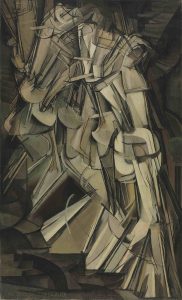Henri-Robert-Marcel Duchamp was a French-American painter, sculptor, chess player, and writer whose works are associated with Cubism, Dada, and Conceptual Art. He was careful about his use of the term Dada and was not directly associated with Dada groups.

Image source: https://search.creativecommons.org/photos/2b5b6f59-7656-41f5-aac0-dcc1c473f6f9 by y.caradec
Few artists can boast of having changed the course of art history in the way that Marcel Duchamp did. By challenging the very notion of what is art, his first readymades sent shock waves across the art world that can still be felt today. In his insistence that art should be driven by ideas above all, Duchamp is generally considered to be the father of Conceptual art.
Early life

Although Duchamp’s father was a notary the family had an artistic tradition stemming from his grandfather, a shipping agent who practiced engraving seriously. Four of the six Duchamp children became artists. Gaston, born in 1875, was later known as Jacques Villon, and Raymond, born in 1876, called himself Duchamp-Villon. Marcel, the youngest of the boys, and his sister Suzanne, born in 1889, both kept the name Duchamp as artists. He learned academic drawing from a teacher who unsuccessfully attempted to “protect” his students from Impressionism, Post-Impressionism, and other avant-garde influences. However, Duchamp’s true artistic mentor at the time was his brother Jacques Villon, whose fluid and incisive style he sought to imitate. At 14, his first serious art attempts were drawings and watercolors depicting his sister Suzanne in various poses and activities. That summer he also painted landscapes in an Impressionist style using oils.
Before Dada
Duchamp’s early art works align with Post-Impressionist styles. He experimented with classical techniques and subjects. When he was later asked about what had influenced him at the time, Duchamp cited the work of Symbolist painter Odilon Redon, whose approach to art was not outwardly anti-academic, but quietly individual.

He studied art at the Académie Julian from 1904 to 1905, but preferred playing billiards to attending classes. During this time Duchamp drew and sold cartoons which reflected his ribald humor. Many of the drawings use verbal puns (sometimes spanning multiple languages), visual puns, or both. Such play with words and symbols engaged his imagination for the rest of his life.In 1905, he began his compulsory military service with the 39th Infantry Regiment, working for a printer in Rouen. There he learned typography and printing processes—skills he would use in his later work.
Readymade
After leaving painting, a stroke of genius led Duchamp to a discovery of great importance in contemporary art, the so-called ready-made. In 1913 he produced the Bicycle Wheel, which was simply an ordinary bicycle wheel. In 1914 Pharmacy consisted of a commercial print of a winter landscape, to which he added two small figures reminiscent of pharmacists’ bottles. It was nearly 40 years before the ready-mades were seen as more than a derisive gesture against the excessive importance attached to works of art, before their positive values were understood. With the ready-mades, contemporary art became in itself a mixture of creation and criticism.

Image source: https://search.creativecommons.org/photos/88321741-eb68-45ee-9c13-8edb5155dcd3
Besides The Large Glass, on which he worked for eight more years until abandoning it in 1923, Duchamp did only a few more ready-mades. One, a urinal titled Fountain, he sent to the first exhibition of the Society of Independent Artists, in 1917. Although he was a founder-member of this society, he had signed the work “R. Mutt,” and therefore it was refused. His ready-mades had anticipated by a few years the Dada movement, which Picabia introduced to New York City in the magazine 291 (1917).
The idea behind the art
Duchamp rejected purely visual or what he dubbed “retinal pleasure,” deeming it to be facile, in favor of more intellectual, concept-driven approaches to art-making and, for that matter, viewing. He remained committed, however, to the study of perspective and optics which underpins his experiments with kinetic devices, reflecting an ongoing concern with the representation of motion and machines common to Futurist and Surrealist artists at the time. A taste for jokes, tongue-in-cheek wit and subversive humor, rife with sexual innuendoes, characterizes Duchamp’s work and makes for much of its enjoyment. He fashioned puns out of everyday expressions which he conveyed through visual means. The linguistic dimension of his work in particular paved the way for Conceptual art.

Image source: https://search.creativecommons.org/photos/ecea17e6-a9a1-4c04-8ead-ba7e78c16366
Info sources: https://www.theartstory.org/artist/duchamp-marcel/ https://en.wikipedia.org/wiki/Marcel_Duchamp https://www.britannica.com/biography/Marcel-Duchamp https://www.moma.org/learn/
